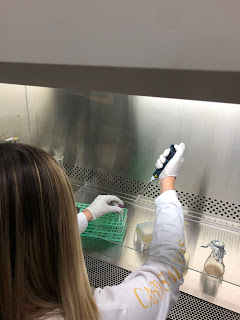Transformation Protocol and PCR Chain Reaction
3/21/18
Dr. Tuohy gave us a project to begin for transferring DNA of D. Gobi and D. Grandis. We briefly touched on how the cell will retain the plasmid and how we will be learning the process of heat shock. We began to look into the scientific paper which was a bit challenging, we skimmed through to find the information we needed. This process is very useful for cloning.
3/24/18
Today we did a PCR Chain Reaction and created a gel. We used the 2, 5, and 7 micro liter pipettes to insert the dye into our gel. The main focus was not puncturing the wall of the gel so we did not get any smearing. In the end our gel turned out the way we had hoped, we anticipated results within the 800 range. The third sample we used showed no results and the NO DNA column was clear which we were looking for as well.


Dr. Tuohy gave us a project to begin for transferring DNA of D. Gobi and D. Grandis. We briefly touched on how the cell will retain the plasmid and how we will be learning the process of heat shock. We began to look into the scientific paper which was a bit challenging, we skimmed through to find the information we needed. This process is very useful for cloning.

3/24/18
Today we did a PCR Chain Reaction and created a gel. We used the 2, 5, and 7 micro liter pipettes to insert the dye into our gel. The main focus was not puncturing the wall of the gel so we did not get any smearing. In the end our gel turned out the way we had hoped, we anticipated results within the 800 range. The third sample we used showed no results and the NO DNA column was clear which we were looking for as well.



That sounds like a really cool project Baylee! That seems like and interesting paper too. It seems like you guys are learning some cool lab techniques for doing transformations! I wonder what types of genes you guys are inserting into the plasmids to transform your bacteria.
ReplyDeleteWow! That’s really cool that you guys did a PCR reaction. I bet that it requires a lot of focus to introduce the genetic material into the little wells. It gets a little tricky, especially if you don’t put the micropipette’s tip inside the well, sometimes the genetic material escapes and the genetic bands don’t come out as good. That’s really cool that your project is going well.
ReplyDelete